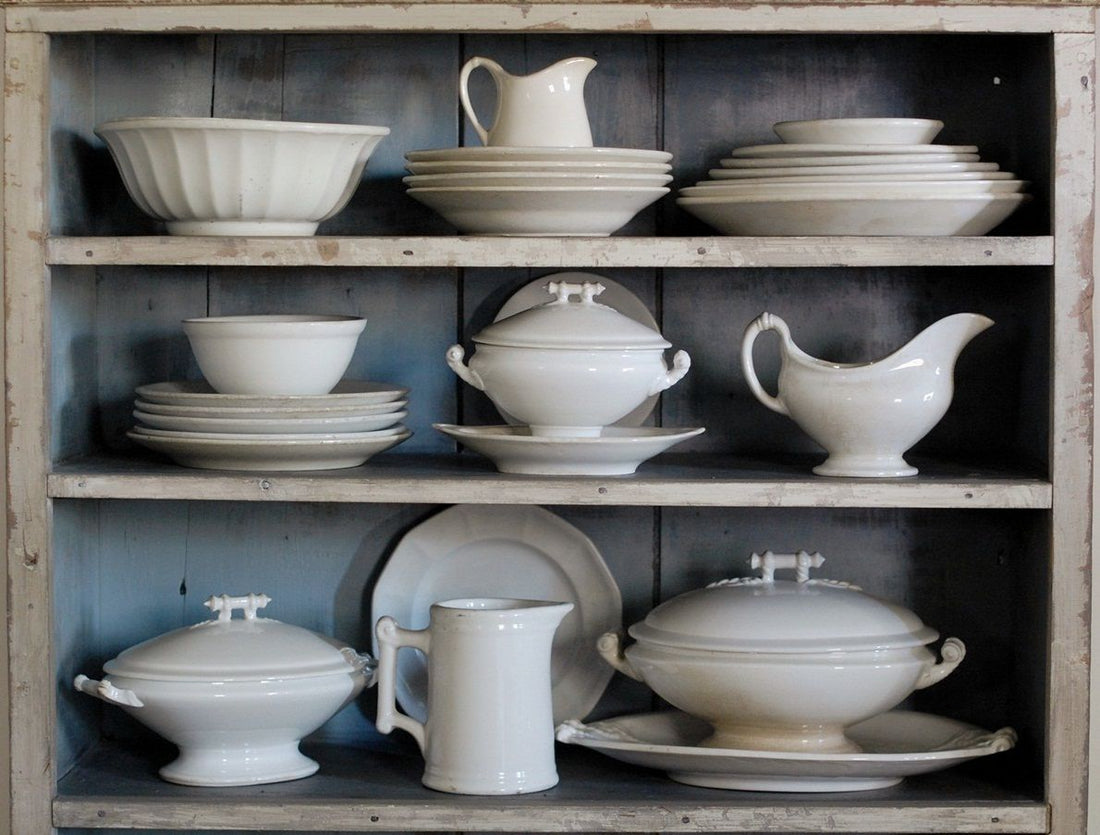So you want to start an ironstone collection? Join the thousands of other 'Ironstone Junkies' who thoroughly enjoy the hunt and adore the history of this beautiful, utilitarian pottery. Although I am not an expert, I am happy to share a few tips to help get you started on your newest obsession: collecting ironstone.
We suggest starting your collection with one or two items, such as pitchers, sugar bowls or small dishes that are easily found and affordably priced. This will give you a chance to understand the true weight of old ironstone and explore various makers, hallmarks and styles. If you decide to jump in feet first, that's ok, too! Just be prepared to do your research so you know what you've found.

Ironstone's European History
Ironstone is essentially a glazed-covered earthenware that has been around for over 200 years. First patented England by Charles James Mason in 1813, other potteries quickly jumped on board. At one point in time, there were over 200 makers of ironstone, mainly in England, France and in the late 1800s, the United States.
Ironstone was made of ironstone slag, flint, Cornish stone, and clay, therefore was heavier and thicker than porcelain. Because is was much more durable and less expensive to produce, it was perfect for everyday use.
Typical pieces made during the 1800s included plates and bowls, serving dishes, casseroles, soup tureens, ladles, gravy boats, pitchers, and even chamber pots.
Some potteries used different names for ironstone china, such as Stone China, Imperial China, White Granite and Royal Patent Ironstone, which were stamped on their pieces. Some of the marks were quite a work of art, as you can see below.
How to Identify Ironstone
Many pieces are identified as ironstone in their hallmark, usually stamped on the bottom. Or, as mentioned above, they may also say 'stoneware' or bear some other description. However, some aren't marked at all. The best way to learn to identify ironstone is to study it when your are out shopping (or hunting, as I like to say). Pick up every piece you find - you'll notice it's usually heavier than it looks. It has a rich luster due to the final glaze, though it may have dulled some depending on the age of the piece. In addition, ironstone is always opaque, never translucent under light.
And, if you think ironstone is always pure white, think again. It can be a cream color, a bluish white or even beige or tea-stained from discoloration and crazing (that's when if the glaze has developed small cracks from aging).
Also, not all ironstone is plain. Many pieces had a transferware design added before the final glaze. A few even have a flow blue design, though porcelain was often the preferred substrate for flow blue. (To be honest, transferware and flow blue both deserve their own post because there's SO much to learn about these delightful types of decorations to plain white china.)
In 2012, I bought a book titled Kovels' New Dictionary of Marks for $2 at Goodwill. I still use it on a regular basis, and don't think I could live without it!! You may want to invest in a good reference book, though much information can be found online.
Old Ironstone Platter with Flow Blue Design
Where to Find It
Antique and vintage ironstone can be found at antique store and markets. But if you have a keen eye, you'll sometimes find it at estate sales, thrift stores, flea markets and yard sales.

Many online vintage sellers offer ironstone on e-commerce platforms such as Etsy and Ebay... even Facebook Marketplace. In addition, a growing number of vintage sellers are launching their own websites in an effort to have better control over the products they sell and how they operate their businesses.
Of course, if you're shopping online, you won't be able to examine and touch the old ironstone piece like you would do 'in person'. So, make sure the online seller provides top notch photos, detailed descriptions, answers your questions promptly, and has a history of excellent service and positive customer reviews.
Price Ranges
It's nearly impossible to develop a price range for ironstone. Just like any other antique, it depends on condition, rarity, age, desirability, size, aesthetic and above all, your personal preference. An ironstone mug would be overpriced at $25 if it was made in the 70s, had a chip on the rim, and a hairline crack on the bottom. But, it could be a steal if it was made in the 1800s in England with a unique pattern. You might find an ironstone bowl at a flea market for $2.00, but the price of a rare antique soup tureen/lid might be $1200.
Most common pieces will go for $25-$65, but expect to pay more for larger, older, patterned pieces. And don't forget that where you live or shop will affect prices, too.
Age and Condition
Ironstone's age can often be determined by the hallmark. As mentioned above, there are books and online sources to help you research your treasure. But sometimes there isn’t a hallmark, or the mark doesn’t give enough information. Especially in older pieces, the hallmarks are often muted or blurry.
Older pieces are typically thicker and heavier than their modern counterparts and have more imperfections in the glazing, coloring, and shape. In newer pieces, the hallmarks are often larger, clearer and tend to have more of a mass produced look. Newer pieces are also more uniform in color with a smoother glaze and less crazing. They are still heavy, but not as thick as antique ironstone.
Conditions of ironstone pieces vary greatly. Some shoppers prefer pure white ironstone with no signs of aging, while others (me included) crave the staining, crazing, bumps and bruises that reveal the character of a life well-lived.
Don't discount a piece because it has visible imperfections. The character from these old pieces are often the authentic vintage vibes you'll want in your home.

Tea Stained Ironstone Gravy Boat
If you decide to remove stains from your ironstone, completely submerge the piece in 3% hydrogen peroxide in a lidded container. Soak for 2-3 days. Remove the ironstone from the container and place it outside in direct sunlight. The hydrogen peroxide will vaporize, removing most stains along with it.
Ironstone Dos and Don'ts
1) Do NOT use liquid bleach to brighten your ironstone. It will weaken the pottery and eventually cause it to break or crumble.
2) Enforcement of leachable lead levels in tableware didn't begin until the late 1970s, according to the FDA. Older ironstone may contain lead in the glaze, and should be taken into account if using to serve food. For example, choosing an antique ironstone platter lined with doilies to serve cupcakes or cookies would be preferable than placing food directly on the platter.
3) Pieces that are chipped, cracked, show heavy crazed, or have other signs of deteriorated glaze should never be used for serving food.
4) Old ironstone should be carefully hand-washed and dried. In addition, it should never be put in an oven or microwave. Newer pieces (though still vintage) will be marked as dishwasher safe and are ideal candidates to use as everyday dishes.
Thanks SO much for stopping by!
If you LOVE vintage as much as we do, subscribe to our weekly newsletter where you’ll enjoy EXCLUSIVE discounts, get tips and articles about living the intentional vintage life, and see the newest additions to our shop.
For our local customers - skip the shipping hassle: If you live in the Columbus, Ohio area, we are happy to forgo shipping charges +/or wait time and personally drop off your purchase. Just send us a message, and we'll coordinate local delivery or pick-up!
Be well, Mary Lou 🌱










